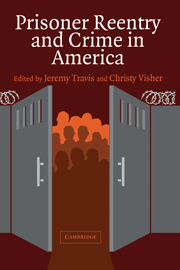Book contents
- Frontmatter
- Contents
- List of Contributors
- 1 INTRODUCTION
- 2 FROM CELL TO SOCIETY
- 3 REENTRY AS A TRANSIENT STATE BETWEEN LIBERTY AND RECOMMITMENT
- 4 THE CONTRIBUTION OF EX-PRISONERS TO CRIME RATES
- 5 DOES SUPERVISION MATTER?
- 6 THE IMPACT OF IMPRISONMENT ON THE DESISTANCE PROCESS
- 7 COMMUNITIES AND REENTRY
- 8 WORK AND FAMILY PERSPECTIVES ON REENTRY
- 9 CONSIDERING THE POLICY IMPLICATIONS
- Index
1 - INTRODUCTION
VIEWING PUBLIC SAFETY THROUGH THE REENTRY LENS
Published online by Cambridge University Press: 05 June 2012
- Frontmatter
- Contents
- List of Contributors
- 1 INTRODUCTION
- 2 FROM CELL TO SOCIETY
- 3 REENTRY AS A TRANSIENT STATE BETWEEN LIBERTY AND RECOMMITMENT
- 4 THE CONTRIBUTION OF EX-PRISONERS TO CRIME RATES
- 5 DOES SUPERVISION MATTER?
- 6 THE IMPACT OF IMPRISONMENT ON THE DESISTANCE PROCESS
- 7 COMMUNITIES AND REENTRY
- 8 WORK AND FAMILY PERSPECTIVES ON REENTRY
- 9 CONSIDERING THE POLICY IMPLICATIONS
- Index
Summary
Overview
One consequence of the fourfold increase in the per-capita rate of incarceration in America is a parallel growth in the number of individuals released from the nation's prisons. In 2001, approximately 630,000 prisoners were released from the nation's state and federal penitentiaries to return home, 4 times more than the number who made similar journeys 20 years ago (Harrison and Karberg 2003). The increased use of imprisonment as a response to crime has received considerable attention in academic circles, among policymakers, and within the general public. There have been spirited debates over the wisdom of indeterminate sentencing, the value of sentencing guidelines, the abolition of parole boards, the emergence of private prisons, the benefits of “three-strikes” laws, the impact of incarceration on racial minorities, and the cost-effectiveness of the network of state and federal prisons constructed to house over a million inmates. Until recently, however, little attention has been paid to one immutable result of building more prisons, namely the reality that more prisoners will be returning home each year.
Recent years have witnessed an explosion of interest in the phenomenon of “prisoner reentry.” Within policy circles, all levels of government have been engaged in sustained examinations of the reentry issue. In his 2004 State of the Union address, President Bush called for a 4-year, $300 million federal initiative to provide jobs, transitional housing, and community support to the nation's returning prisoners, reminding his audience that America is the “land of the second chance” (January 20, 2004).
- Type
- Chapter
- Information
- Prisoner Reentry and Crime in America , pp. 1 - 14Publisher: Cambridge University PressPrint publication year: 2005
- 17
- Cited by

